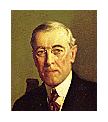| HOME |
America's Entry
Although war was formally declared, the United States was ill prepared. The armed forces consisted of only around 200,000 troops, with an aging officer corps. In addition, the U.S. only had enough ammunition for about two days of fighting. The Selective Service Act required that all men 21-30 register, of which 3 million were drafted. Volunteers and National Guardsmen made up another 1.3 million. Several events and reasons led to America's entry into the Great War. "The United States must be neutral in fact, as well as in name, during these days that are to try men's souls," stated President Wilson in 1914. This sentiment was consistent with the popular opinion of most Americans at the time. However, the United States was definitely pro-British and continually supplied the Allies throughout the war.
Another
major reason for America's entry into the war was the infamous Zimmerman
Telegram. In January of 1917, the British deciphered a
telegram from German Foreign Minister Arthur Zimmerman to the German
Minister to Mexico, von Eckardt. In this message, Germany offered
Mexico territory in the United States in return for joining the Central
Powers. Zimmerman pledged that Germany would assist them in "reconquering"
their lost territory in Texas, New Mexico, and Arizona. The
American press published news of the telegram on March 1. A little
more than a month later and the United States declared war.
Czar Nicholas II was dethroned in the "February Revolution" of 1917, after which Russia made little contribution to the war effort. The incredible losses on the battlefield and the failure of the Provisional Government to improve conditions at home made Russia ripe for another Revolution. In November, led by V.I. Lenin, the Red Guard stormed the Winter Palace and seize control. The "Bolshevik Revolution" led to the establishment of a Socialist Russia, and they officially pulled out of the war through the Treaty of Brest-Litovsk in March, 1918. By this time, the United States was already mobilizing for war. |
||
| MAIN | |||
| INVESTIGATION HOME | |||
|
TIMELINE: Check out this timeline on America and the Great War. |
|||
|
MAIN EVENTS: Who started the Great War? An interesting list of countries and how they got entangled in the war. |
|||
|
LINKS: Links, links, and more links to a world of fascinating information on the Great War. Look at documents, propaganda, music, poetry, and more... |
|||
|
ZIMMERMAN
TELEGRAM: Germany told Mexico to declare war on the United States. Decode a fictitious message using a simple substitution code. |
|||


